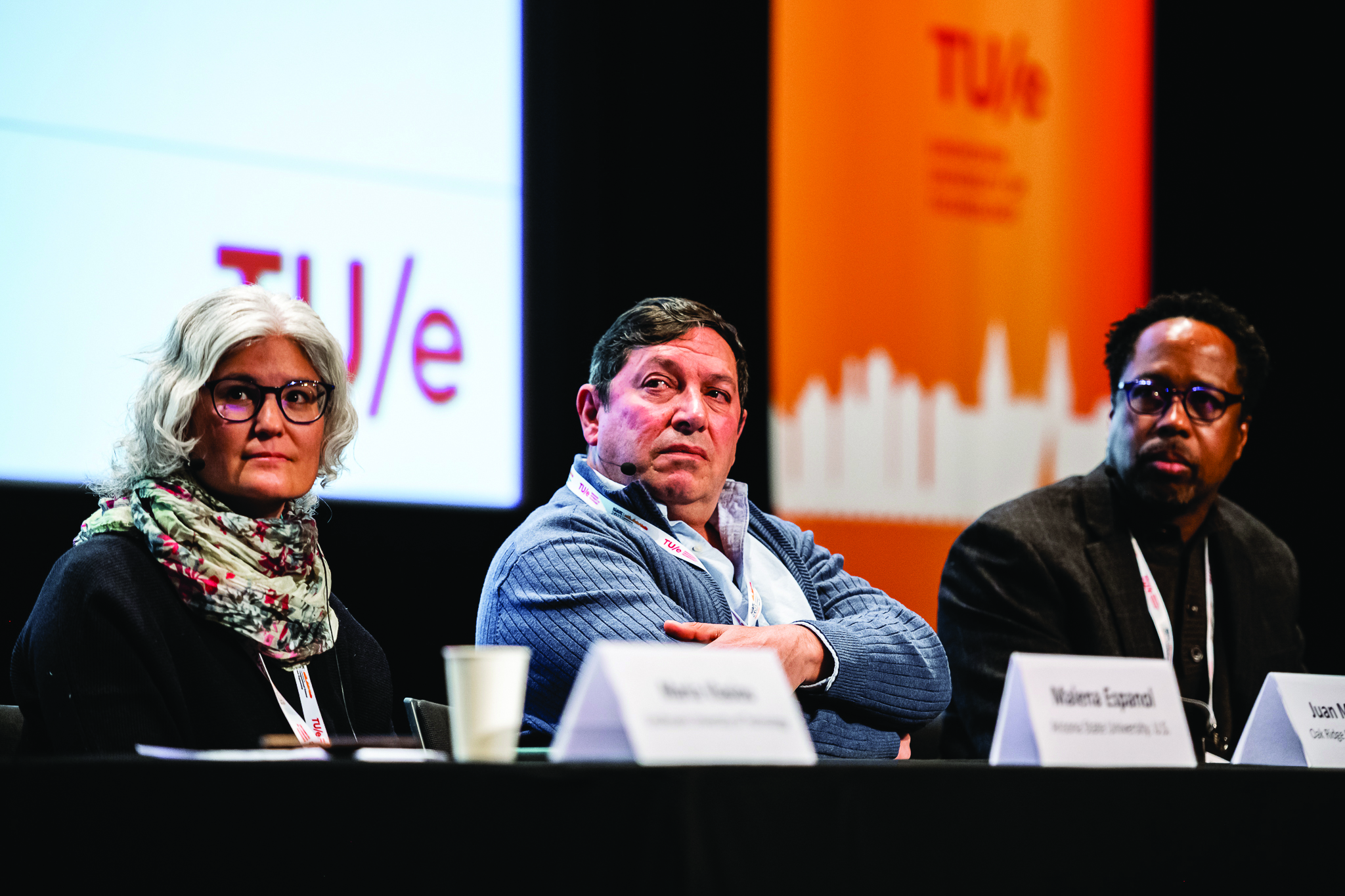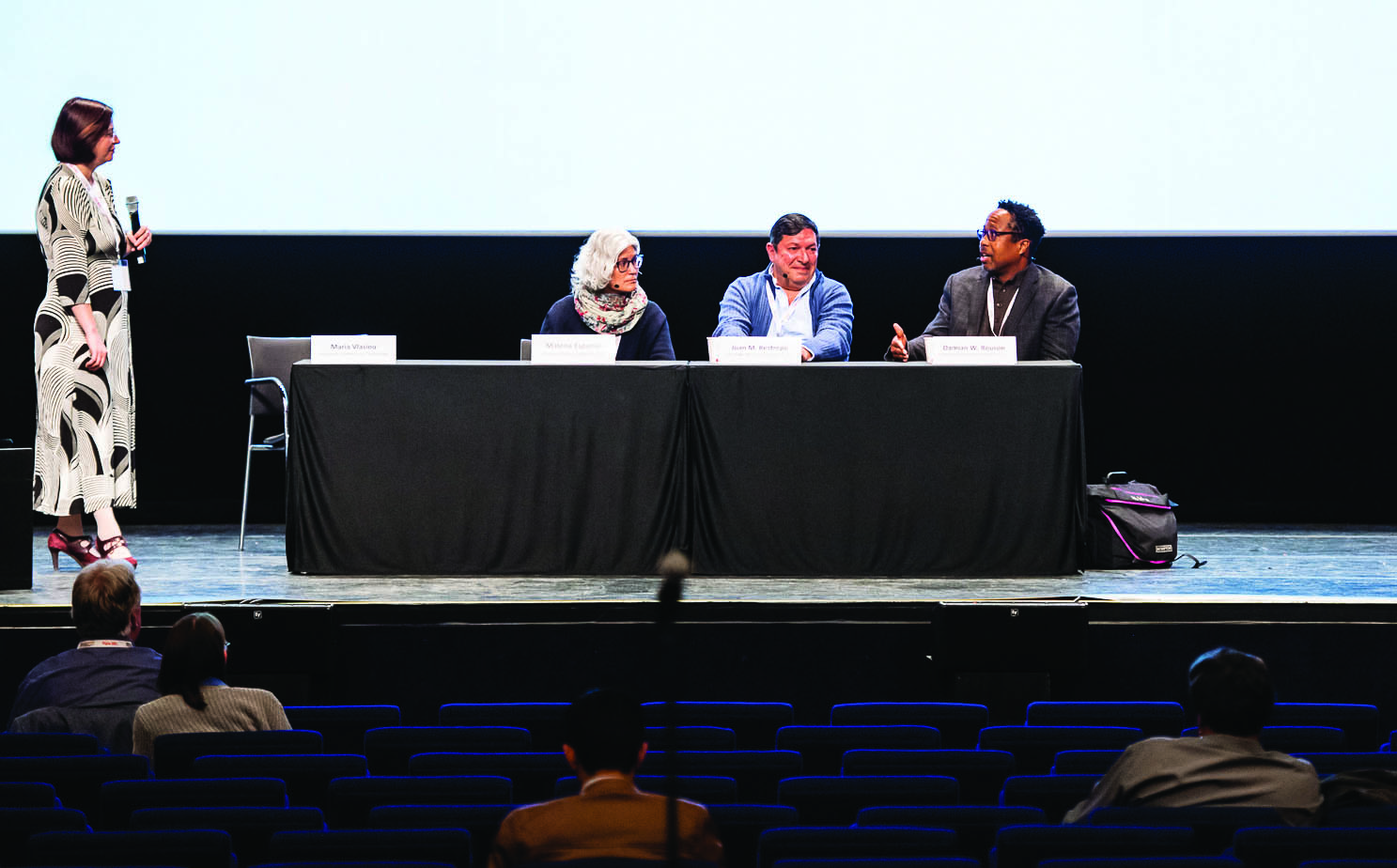Diversity and Retention in the Workforce Take Center Stage at CSE23
As universities and other research institutions take active steps to increase diversity and representation amongst their staff, the retention of minority populations remains a significant challenge at numerous organizations. Despite ongoing strategic recruitment efforts, many groups remain underrepresented in the applied mathematics and computational science workforce. During the 2023 SIAM Conference on Computational Science and Engineering, which took place earlier this year in Amsterdam, the Netherlands, a panel session addressed diversity retention and mentoring in the workplace. Panelists Malena Español (Arizona State University), Juan Restrepo (Oak Ridge National Laboratory), and Damian Rouson (Lawrence Berkeley National Laboratory) shared personal insights based on their own experiences, endorsed the value of mentorship, and offered strategies to support employees from minority groups. Maria Vlasiou (Eindhoven University of Technology) moderated the constructive conversation.

Español opened the discussion by affirming that the retention of faculty members from diverse backgrounds requires intentional decision making. “Everything starts with the hiring process,” she said. “We need to have a clear vision of where we want our institutions to go and hire accordingly, and that will affect retention.” Hiring committees must therefore consider both research experience and commitment to inclusivity when reviewing resumes and interviewing prospective employees.
Restrepo explained that hiring and retention are two separate challenges, noting that the retention pipeline in the U.S. appears to be broken between postdoctoral appointments and full-time employment. In response, he urged employers to protect and support members of underrepresented communities on their staff. “Most come in very excited and energetic, and I don’t want them to become tokens for the organization,” Restrepo said. For example, people of color should not automatically be tasked with greeting visitors from historically Black colleges or universities; instead, these employees should have the same opportunities as their coworkers to focus on their careers. Restrepo also suggested a change to the way in which society views members of marginalized populations — e.g., as “professional mathematicians who happen to be women” rather than “women who happen to be professional mathematicians.”
Rouson, who has worked at three different government laboratories, explained that lab recruitment is often driven by narrow project needs. Hiring groups search for individuals with specific technical backgrounds, which often makes it difficult to attract a large and diverse candidate pool. Because people frequently hire through their own networks, Rouson urged scientists to actively expand their connections. “Part of what we have to do is get out to a different set of places than where we’ve been going,” he said. In addition, he highlighted the Sustainable Horizons Institute’s Sustainable Research Pathways initiative: a workforce development program that connects faculty and students from underrepresented groups with scientists at the U.S. Department of Energy National Laboratories.
Reaching a “critical mass” of employee diversity is another important component of retention. “When you’re the only one, it can be a very lonely experience,” Rouson continued. “We have affinity to people who are like us, that’s just a natural thing. If you’re in a group that’s the majority, you’re more likely to benefit from the natural circles that arise.” Employee resource groups and workplace affinity groups combat this phenomenon by uniting underrepresented minorities within larger settings and creating a sense of community to reduce feelings of isolation.
Positive mentor-mentee relationships can achieve a similar effect, especially when the mentor listens to both the professional and personal needs of the mentee. “Mentoring is helping someone navigate not just work, but also life,” Español said. A certain level of overlap usually exists between an individual’s professional and personal situations, so she advised mentors to view their mentees holistically. Moreover, Español reminded junior researchers to seek out multiple types of mentors, each of whom serves a specific purpose for career advancement. The newly established SIAM Postdoctoral Support Program, which is currently accepting applications, provides up to $15,000 in financial support for postdoctoral researchers to work with mentors at different institutions. The goal is to foster research collaboration and professional development; up to four postdoc/mentor pairs will be selected annually beginning in the summer of 2023.
Rouson spoke fondly of his graduate advisor at Stanford University. “The most impactful mentoring that I experienced was my Ph.D. advisor,” he said. “Mentoring plays a huge role in retention, and I wouldn’t have made it through that program without him.” He recalled a bike ride with his Ph.D. group that involved a steep uphill climb. One of the students was struggling, so Rouson’s advisor rode alongside her and alternately pushed and pulled her up the hill. Rouson used this story as a metaphor for an effective mentoring style; his advisor employed a hands-on approach when necessary and actively helped Rouson select courses and design his schedule when he was floundering.

Español observed that numerous networking, funding, and research opportunities are severely underutilized, and encouraged educators—including faculty, advisors, and other mentors—to promote such opportunities amongst their students as much as possible. Even simply emailing relevant postings and application portals to entire classes can be helpful, as many students are perfectly qualified but unaware of the prospects that are available to them. This type of clear communication is particularly valuable for first-generation college students, who may not have the same knowledge of academic stipulations as their peers.
When it comes to mentorship, Restrepo believes in quality over quantity. He remarked that mentors and mentees should sometimes connect across different groups or departments within an organization in order to establish broader relationships. The postdoctoral researchers that Restrepo employs at Oak Ridge—where he is head of the Mathematics in Computation Section—write individual development plans for themselves, then work with their mentors to craft private documents that outline the expectations of both parties. These documents address objectives like the number of conference talks to present and papers to submit within a certain timeframe. Restrepo then meets with the postdocs once a year to check in and hear about their experiences.
As group lead of the Computer Languages and Systems Software Group at Lawrence Berkeley, Rouson intentionally arranges mentor-mentee relationships and actively introduces pairs when there is the prospect of mutual gain. If a staff member will soon be mentoring junior faculty due to an upcoming promotion, for example, Rouson prepares them for this responsibility by connecting them with students or other individuals who could benefit from additional guidance. “By being intentional about developing mentored relationships, you will also in some ways have a more powerful impact on those who are in the minority,” he said.
Conversation then turned to the importance of new ideas and novel recruitment and retention methods. “Diversity is an issue of social justice, but it’s also an issue of innovation,” Restrepo said. “If your dean or president doesn’t understand the very notion of innovation and you don’t have a system that allows for taking chances—in a tenure situation, for example—you’ll have trouble getting the idea of retention through.” He pointed out that some faculty who were first-generation college students, while just as technically competent as their colleagues, might require additional support or flexibility when applying for tenure. “There is no reason to have tenure clocks be so rigid that they don’t allow for certain circumstances in life,” Restrepo continued.
Next, Vlasiou directed the discussion towards gender diversity. In a policy context, analysts typically use a glass-ceiling index to measure the role and influence of women in the workforce as they pursue managerial and executive-level positions. Rouson encouraged attendees to consider the glass-ceiling index and other assessments of diversity with the same type of analytical thinking that they apply to their mathematical research. “We as scientists need to get more quantitative, rigorous, and analytical about these questions — just as we are with the science itself,” he said. In some cases, a passion for equal representation in the workforce can even inspire new mathematical analyses.
Departments that are working to increase retention often solicit input from their early-career members. However, Restrepo reminded directors to also consult more established employees who have lengthy firsthand experience with the metaphorical glass ceiling. “A lot of my female colleagues say that they don’t have job satisfaction because they don’t feel appreciated,” he said. “These folks did the battle, they feel like they worked really hard and achieved quite a bit scientifically. But when they’re not consulted on issues of diversity and so forth, they feel like they’re being left out.”
As the panel drew to a close, Español commented that both policy and workforce culture must change in order to improve retention in the long term. She acknowledged the value of established rules of conduct, which are becoming more common in classroom settings and at conferences and other gatherings. Nevertheless, a great deal of necessary progress remains to be made. Español recommended that scientists continue to have difficult, intentional conversations about preexisting procedures and policies, especially with the upcoming generation of researchers. “Sometimes we hit bumps, but I think society is moving in the right direction,” she said.
Further Reading
Hofstra, B., Kulkarni, V.V., Munoz-Najar Galvez, S., He, B., Jurafsky, D., & McFarland, D.A. (2020). The diversity-innovation paradox in science. Proc. Natl. Acad. Sci., 117(17), 9284-9291.
About the Author
Lina Sorg
Managing editor, SIAM News
Lina Sorg is the managing editor of SIAM News.

Stay Up-to-Date with Email Alerts
Sign up for our monthly newsletter and emails about other topics of your choosing.



